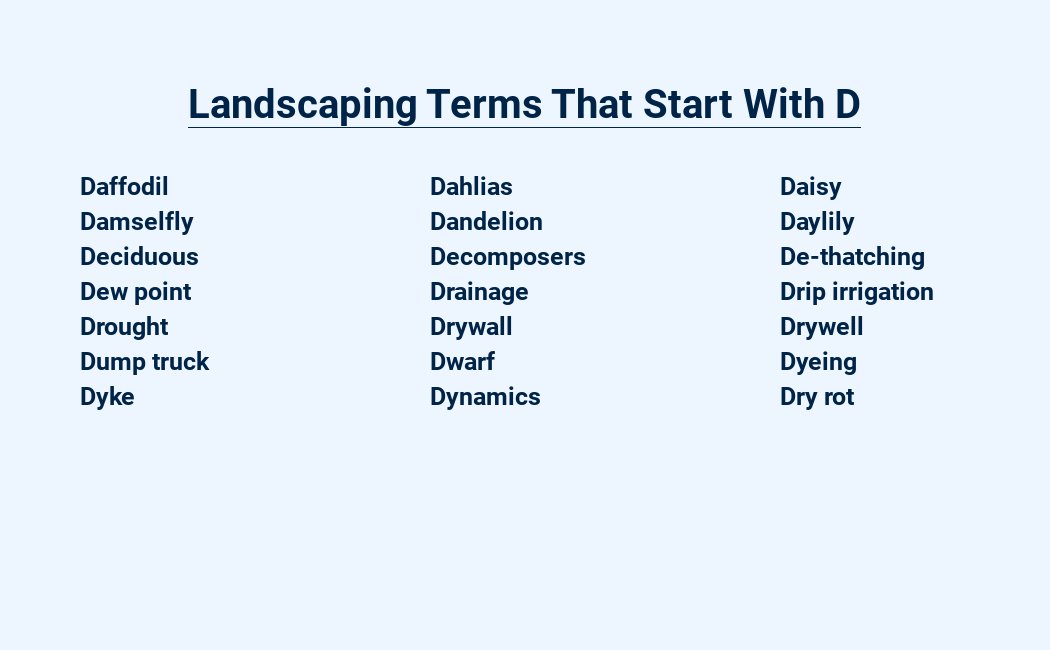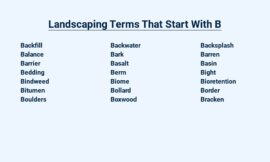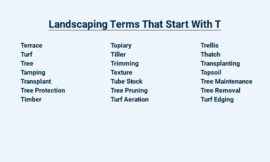From dams controlling water flow to deadheading promoting new blooms, the world of landscaping is filled with diverse terms starting with D. Discover a comprehensive glossary of essential landscaping terminology, ranging from understanding deciduous trees’ seasonal changes to implementing water-saving drip irrigation systems.
Explore the art of creating desertscapes, incorporating drought-resistant plants, and cultivating compact dwarf plants for aesthetic appeal.
| Term | Description |
| Deciduous | Trees or shrubs that lose their leaves annually. |
| Deadheading | The removal of spent flowers from a plant to encourage new growth and blooming. |
| Deciduous | A plant that sheds its leaves in the fall. |
| Drip irrigation | A method of irrigation that uses slow, steady drips of water to water plants. |
| Drought-tolerant | Plants that can survive with little water. |
Landscaping Terms that Start with D
Dam
A dam is a structure built to obstruct the flow of water and create a reservoir.
Dams are often used for water supply, irrigation, flood control, hydroelectric power generation, and recreation.
They can be made of various materials, including concrete, earth, or rock.
Deadheading
Deadheading involves removing spent blooms from plants to encourage new growth and flowering.
This practice helps maintain a tidy and visually appealing landscape while promoting plant health and vigor.
Deciduous
- Deciduous: Refers to plants that seasonally shed their leaves, typically in autumn or winter.
- This shedding is an adaptation to conserve water and energy during periods of cold or drought.
- Common deciduous trees include oak, maple, and birch.
Decomposers
Decomposers play a vital role in the ecosystem by breaking down organic matter into simpler substances.
This process, known as decomposition, helps recycle nutrients back into the soil, making them available for plants to absorb and utilize.
Examples of decomposers include bacteria, fungi, and worms.
Desertscaping
Desertscaping is a landscaping technique that minimizes water usage in arid and semi-arid regions.
It involves using drought-tolerant plants, efficient irrigation systems, and hardscaping elements to create a beautiful and sustainable landscape.
Drip Irrigation
Drip irrigation is a watering system that delivers water directly to the roots of plants.
It conserves water and reduces evaporation, making it an efficient irrigation method for landscapes, gardens, and agricultural fields.
Drip irrigation systems can be customized to fit the specific needs of different plants and landscapes.
Drought-Resistant Plants
Drought-resistant plants are those that have adapted to survive in dry conditions with minimal water.
These plants typically have deep roots, thick leaves, and a waxy coating that helps them retain moisture.
Drought-resistant plants are a great choice for gardens in arid climates or for those who want to conserve water.
Dwarf Plants
Dwarf plants, characterized by their compact size, are often used in landscaping for edging, ground cover, and rock gardens.
Their slow growth and minimal maintenance requirements make them popular choices for both residential and commercial landscapes.
Final Verdict
In the realm of landscaping, a plethora of terms beginning with “D” hold significant importance. From the grandeur of dams shaping water features to the delicate art of deadheading spent blooms, each term adds depth and dimension to the world of horticulture.
Deciduous trees shed their leaves seasonally, creating a stunning tapestry of colors.
Decomposers break down organic matter, enriching the soil and fostering new life. Desertscaping embraces the beauty of arid landscapes, while drip irrigation conserves water and nourishes plants efficiently.
Drought-resistant plants thrive in dry conditions, adding resilience to any garden.
Lastly, dwarf plants bring a touch of charm and variety to landscapes, offering unique textures and forms. These terms, among others, form the foundation of landscaping knowledge, guiding us in creating harmonious and sustainable outdoor spaces.




